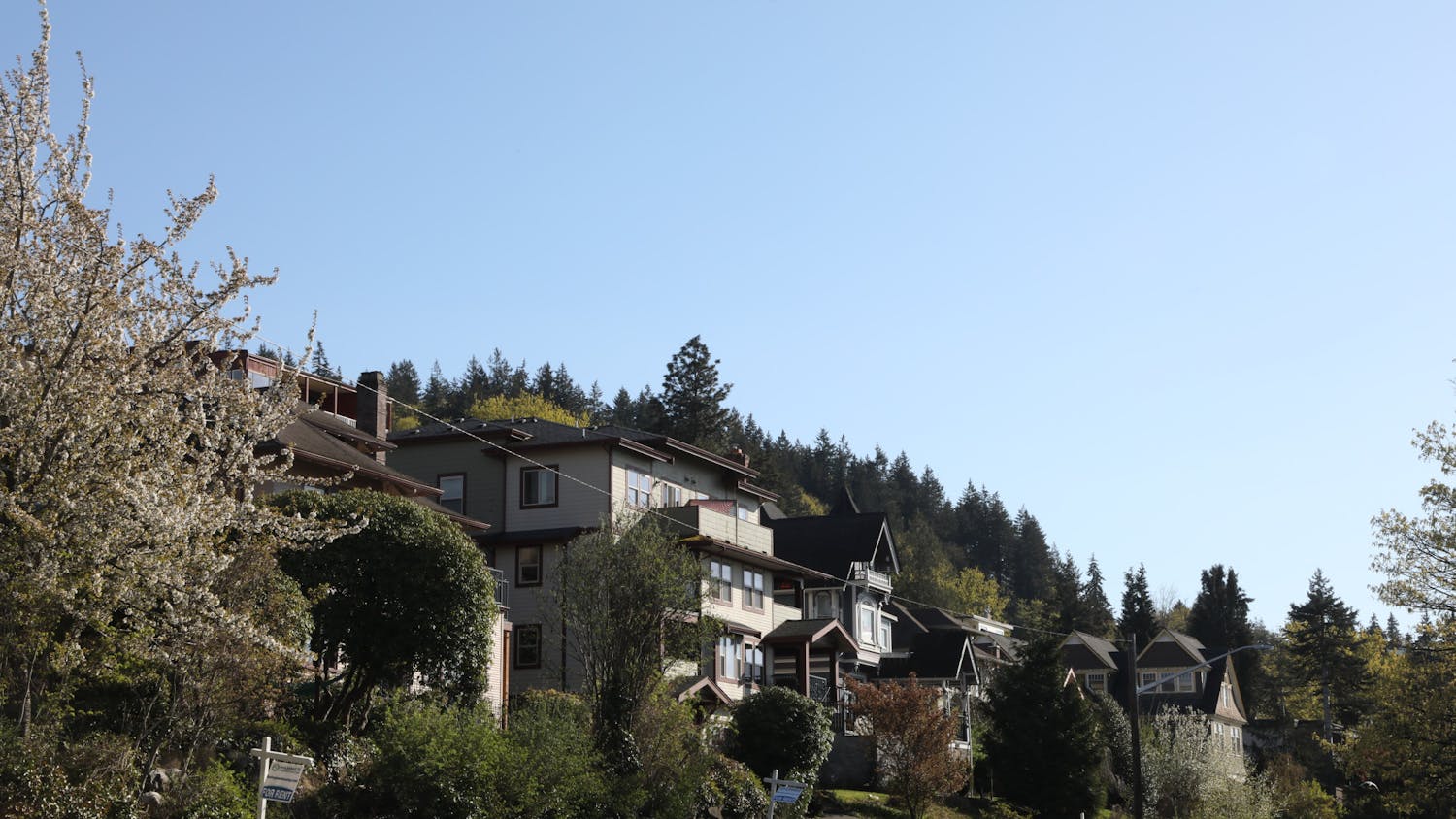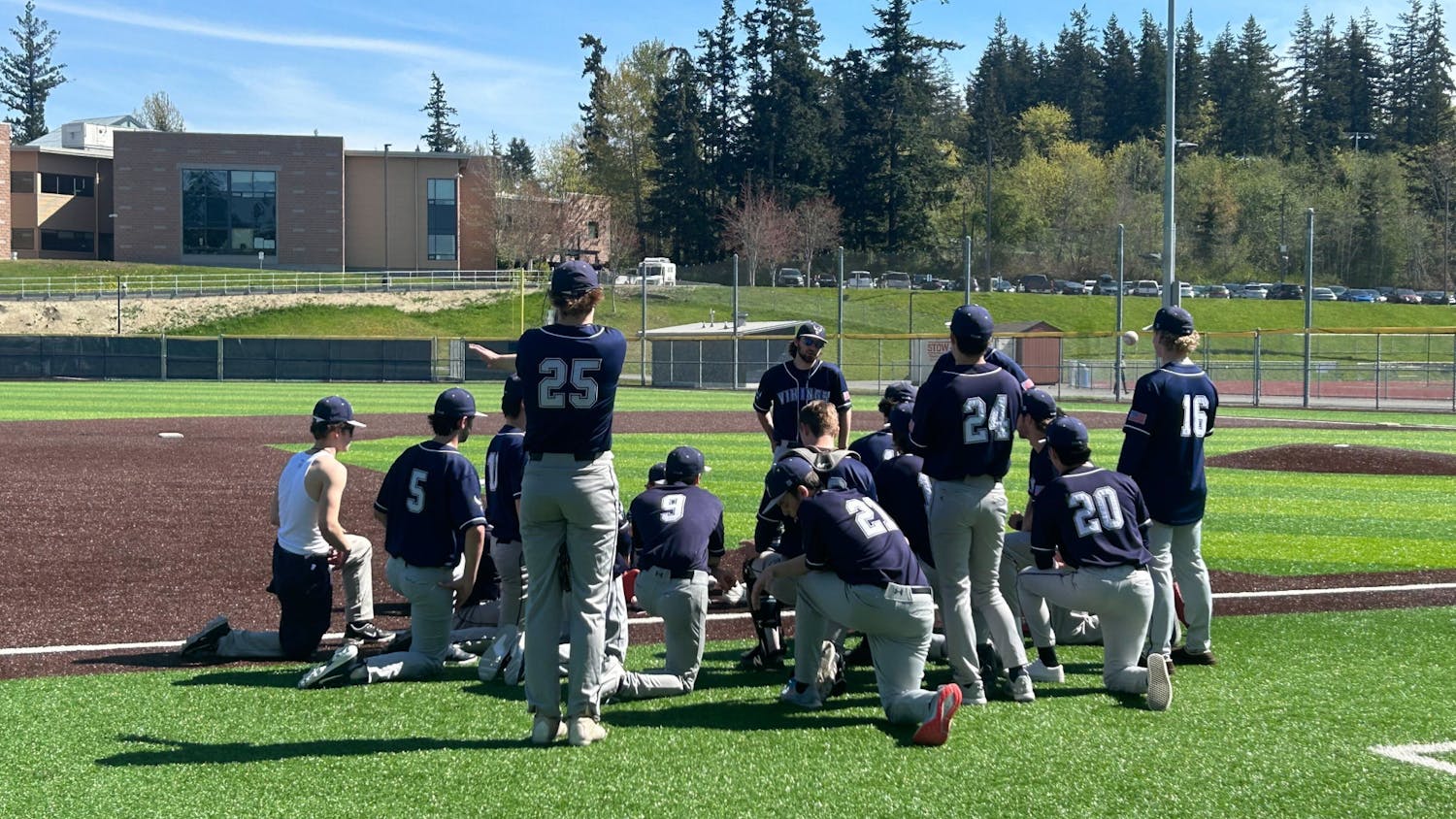[caption id="attachment_672" align="alignleft" width="864"] Cadet Commander Cassidy Ratayczak inspects the uniform of another cadet during a uniform inspection on Tuesday, April 14. // Photo by Jake Tull[/caption]
The cadets of Bellingham Civil Air Patrol stand at attention in complete silence. The cadets, ages 12 to 17, clad in camouflage uniforms, wait motionless for their orders. Tonight, each of the cadets’ uniforms will be inspected and evaluated. The scores they receive on these inspections will help decide when they receive their next promotion.
Cadet Commander Cassidy Ratayczak, 17, approaches one of the cadets to examine their uniform. She whispers a few comments to another cadet with a clipboard, who scribbles something down. Ratayczak makes a few small adjustments to the cadet’s uniform and moves to inspect the next cadet.
Civil Air Patrol is a volunteer auxiliary to the U.S. Air Force that focuses on the three missions of aerospace education, emergency services and cadet programs. CAP is divided into two age groups: the cadet members from 12 to 17 years old, and senior members 18 and older.
The aerospace education program is designed to educate CAP members about aviation and space exploration, as well as aerospace technologies and national security. CAP also offers lesson plans, reading material and other aerospace education related information for educators to incorporate into their own teaching.
Robert Bragg, a Western graduate and neuroscience research technologist, is a CAP aerospace education officer and gives a lesson once a month to cadets on a variety of aerospace subjects.
“That can range from anything, from how airplanes fly and how they work, to stuff that’s more science based, like astronomy,” Bragg said.
Bragg joined in order to work toward his pilot license. CAP often has certified flight instructors in the squadron to help new members, Bragg said.
The Bellingham squadron has its own planes, which play a large role in their support capabilities for search and rescue and disaster relief.
CAP also contributes to ground operations in emergency situations, which the cadets actively participate in, CAP Bellingham Squadron Commander Tim Kelley said. The cadets help largely with making sure that everyone involved in CAP operations are accounted for, including aircraft and pilots, as well as operating radios and helping with communications.
“We put a lot of responsibility on them,” Kelley said. “My cadet commander is 17 years old and she’s got 40 other people she’s responsible for.”
The most recent mission they were a part of was the Oso mudslide in March 2014, said Ralph Black, director of operations for the Washington wing of CAP.
“Right from the onset of the slide we provided air communications, photography, de-conflicting of traffic and a number of other activities for the state,” Black said.
The mudslide had wiped out all cell towers and landlines in the area, said Aran Clauson, CAP Safety Officer and computer science professor at Western.
“The radios we use are all line-of-sight,” Clauson said. “Oso doesn’t really lend itself [to that]. It’s not Kansas.”
The signal from line-of-sight-radios can be blocked by obstructions, such as hills, mountains, trees or buildings. CAP provided airplanes carrying airborne repeaters, which allowed radio communication in the hills and forested areas, Black said.
“It’s really important,” Clauson said. “When FEMA [Federal Emergency Management Agency] ground crews are looking through houses they can actually radio in and contact base.”
CAP also does a large amount of aerial photography for government organizations, such as FEMA.
“FEMA will pay our squadron to take photos of coastline,” Bragg said.
The squadron will photograph the coastline about once every year or once every six months so that FEMA can see how the shoreline changes, Bragg said. CAP will also provide aerial photography of disaster areas and provide them to FEMA so they can more accurately assess damages to that area.
“It’s amazing the resolution we shoot these [photographs] to,” Black said.
Ratayczak has been involved in CAP for over five years and was appointed her current position at the end of September 2014.
“My favorite part about being in [CAP] is the leadership and getting to train these young cadets,” Ratayczak said. “Seeing them grow and promote and learn leadership and followership was the most inspiring and exciting thing for me.”
Last month, CAP organized a search and rescue training operation. Ratayczak was involved as the communications unit leader. She trained new cadets how to use the radios, established a communication plan for operations staff and briefed her staff on the protocols for the day.
“The first time I did it, it was pretty stressful,” Ratayczak said. “But now it’s pretty routine for me.”
During these training exercises, different scenarios are created to challenge the cadets and simulate problems that may arise during an operation. This includes cutting power to their equipment or having aircraft pilots land their planes and not respond to radio check-ins.
“It’s definitely impressive,” Bragg said. “Especially in situations where they’re in charge.”
Ratayczak graduated from Windward High School in Ferndale and received an associate degree from Whatcom Community College last June. She plans on getting her bachelor’s degree in biochemistry and complete a pre-medicine program, possibly at Western. She hopes to then join the Air Force and become a doctor.
“She has her life more together than I did when I was 17,” Clauson said.
The CAP cadet program is designed to teach cadets about leadership skills and service to their community. For some kids, it helps them find direction in their own lives, Kelley said. The cadet program prepares them with a multitude of skills from organization to professional interviews to leadership and self-confidence.
“We do give them a lot of responsibility quickly,” Kelley said. “Let somebody go and you’d be amazed at what they can do.”
Cadet Commander Cassidy Ratayczak inspects the uniform of another cadet during a uniform inspection on Tuesday, April 14. // Photo by Jake Tull[/caption]
The cadets of Bellingham Civil Air Patrol stand at attention in complete silence. The cadets, ages 12 to 17, clad in camouflage uniforms, wait motionless for their orders. Tonight, each of the cadets’ uniforms will be inspected and evaluated. The scores they receive on these inspections will help decide when they receive their next promotion.
Cadet Commander Cassidy Ratayczak, 17, approaches one of the cadets to examine their uniform. She whispers a few comments to another cadet with a clipboard, who scribbles something down. Ratayczak makes a few small adjustments to the cadet’s uniform and moves to inspect the next cadet.
Civil Air Patrol is a volunteer auxiliary to the U.S. Air Force that focuses on the three missions of aerospace education, emergency services and cadet programs. CAP is divided into two age groups: the cadet members from 12 to 17 years old, and senior members 18 and older.
The aerospace education program is designed to educate CAP members about aviation and space exploration, as well as aerospace technologies and national security. CAP also offers lesson plans, reading material and other aerospace education related information for educators to incorporate into their own teaching.
Robert Bragg, a Western graduate and neuroscience research technologist, is a CAP aerospace education officer and gives a lesson once a month to cadets on a variety of aerospace subjects.
“That can range from anything, from how airplanes fly and how they work, to stuff that’s more science based, like astronomy,” Bragg said.
Bragg joined in order to work toward his pilot license. CAP often has certified flight instructors in the squadron to help new members, Bragg said.
The Bellingham squadron has its own planes, which play a large role in their support capabilities for search and rescue and disaster relief.
CAP also contributes to ground operations in emergency situations, which the cadets actively participate in, CAP Bellingham Squadron Commander Tim Kelley said. The cadets help largely with making sure that everyone involved in CAP operations are accounted for, including aircraft and pilots, as well as operating radios and helping with communications.
“We put a lot of responsibility on them,” Kelley said. “My cadet commander is 17 years old and she’s got 40 other people she’s responsible for.”
The most recent mission they were a part of was the Oso mudslide in March 2014, said Ralph Black, director of operations for the Washington wing of CAP.
“Right from the onset of the slide we provided air communications, photography, de-conflicting of traffic and a number of other activities for the state,” Black said.
The mudslide had wiped out all cell towers and landlines in the area, said Aran Clauson, CAP Safety Officer and computer science professor at Western.
“The radios we use are all line-of-sight,” Clauson said. “Oso doesn’t really lend itself [to that]. It’s not Kansas.”
The signal from line-of-sight-radios can be blocked by obstructions, such as hills, mountains, trees or buildings. CAP provided airplanes carrying airborne repeaters, which allowed radio communication in the hills and forested areas, Black said.
“It’s really important,” Clauson said. “When FEMA [Federal Emergency Management Agency] ground crews are looking through houses they can actually radio in and contact base.”
CAP also does a large amount of aerial photography for government organizations, such as FEMA.
“FEMA will pay our squadron to take photos of coastline,” Bragg said.
The squadron will photograph the coastline about once every year or once every six months so that FEMA can see how the shoreline changes, Bragg said. CAP will also provide aerial photography of disaster areas and provide them to FEMA so they can more accurately assess damages to that area.
“It’s amazing the resolution we shoot these [photographs] to,” Black said.
Ratayczak has been involved in CAP for over five years and was appointed her current position at the end of September 2014.
“My favorite part about being in [CAP] is the leadership and getting to train these young cadets,” Ratayczak said. “Seeing them grow and promote and learn leadership and followership was the most inspiring and exciting thing for me.”
Last month, CAP organized a search and rescue training operation. Ratayczak was involved as the communications unit leader. She trained new cadets how to use the radios, established a communication plan for operations staff and briefed her staff on the protocols for the day.
“The first time I did it, it was pretty stressful,” Ratayczak said. “But now it’s pretty routine for me.”
During these training exercises, different scenarios are created to challenge the cadets and simulate problems that may arise during an operation. This includes cutting power to their equipment or having aircraft pilots land their planes and not respond to radio check-ins.
“It’s definitely impressive,” Bragg said. “Especially in situations where they’re in charge.”
Ratayczak graduated from Windward High School in Ferndale and received an associate degree from Whatcom Community College last June. She plans on getting her bachelor’s degree in biochemistry and complete a pre-medicine program, possibly at Western. She hopes to then join the Air Force and become a doctor.
“She has her life more together than I did when I was 17,” Clauson said.
The CAP cadet program is designed to teach cadets about leadership skills and service to their community. For some kids, it helps them find direction in their own lives, Kelley said. The cadet program prepares them with a multitude of skills from organization to professional interviews to leadership and self-confidence.
“We do give them a lot of responsibility quickly,” Kelley said. “Let somebody go and you’d be amazed at what they can do.”





